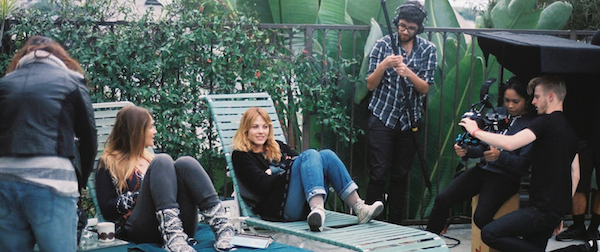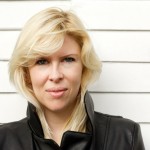Catherine Hardwicke was “mind blowing.”—And other big things that happened in Directing Lab

Film Independent’s 2105 Directing Lab just came to an end last month. The intensive eight week program is designed to help directors who are prepping their feature films. During the Lab, Fellows workshop scenes with esteemed filmmakers who provide guidance and advice. We asked one of this year’s Fellows, Sylvia Sether, to share her experience.
What is your project about and what was the genesis for this film?
King of Norway is loosely based on my relationship with my father who passed away in June 2011. I initially lost my dad to an accident in 1989 when I was seven years old. A serious head injury left him brain damaged and confined to a nursing home for the rest of his life. It was heartbreaking and heart opening to navigate the illusive grief that surfaces when someone is alive—but not really there. It felt as if he died that day—only he didn’t. A fragmented version of my father remained living in the nursing home for the remaining 23 years he was alive.
At a young age, I came to understand that this world is a terribly difficult and extraordinary place. Although my dad’s accident was the most tragic event of my life, it has also been the most inspiring. It validated for me that we are all connected on a much deeper level, and that things are not always what they seem. It also made me realize how things can change in the blink of an eye, and that our time here is short and important. Death teaches us a lot about how to live fully—if we let it.
King of Norway is about a twenty-something young woman, who returns to Norway to say goodbye to her dying father, and in the process finds deliverance through love and letting go. The lead character Liv is inhibited by the grief and regret of her past, and it’s manifested as a substance abuse problem, among other counter-productive habits. When Liv arrives in Norway she is forced to face all the demons she’s been running from, which results in her becoming the catalyst for the entire family to face the past and find healing in the truth. Liv’s father being stuck in between life and death for all these years also mirrors this strange limbo they have found themselves in.
At its core, the film is about how pain and joy are two sides of the same coin, and it explores the idea that an unshakable happiness might be found in the grey area between the two.
 What was it like working with your creative advisor Catherine Hardwicke in the Lab?
What was it like working with your creative advisor Catherine Hardwicke in the Lab?
Working with Catherine was INCREDIBLE. She was beyond generous with her time and knowledge of filmmaking. It was super enlightening. I feel very grateful to have spent so much time with her.
Catherine is a bottomless well of insight and inspiration, not to mention one of the most enthusiastic, hard working and all around badass directors I’ve had the privilege to work with. The one-on-one time I got with her was mind blowing. She explained in detail how she works as a director from prep through post, and also gave me indispensable feedback on my scenes, and then on my script as a whole. Our in-class rehearsal together was surreal… it was wonderful to witness the way she works with actors and the way she approaches material. It’s such a rare opportunity to collaborate with another director like that—I will never forget my time with her. Her mentorship has most definitely elevated my storytelling skills, especially working with actors, which was something I was hungry to focus on.
How did the process of workshopping two scenes inform your process as a director or your vision for the film?
The very specific way that the lab is set up is a pretty unusual and an amazing opportunity. The lab creates a professional but safe environment to explore the material in a way that you don’t normally get the luxury of.
The epicenter of the lab is rehearsal/performance, which was exactly the thing I needed to click into as I prepare to shoot the film later this year. Exploring the material in rehearsal with my actors, then with Catherine, on the shoot day, and then in our classroom critique really validated a lot of things that are working about my process, and shifted many others, helping my process evolve into something way more clear and tangible than I could have imagined. It was also a strong reminder that performance is everything. If it’s not authentic, connected and moving, it doesn’t matter what your budget is or what camera you’re shooting on.
I’ve always been the kind of director who is into over preparing, but that understanding deepened in a lot of ways during the lab. I was reminded that all that preparation really helps you let go on the day, giving you the ability to be more present and go with the flow of what is evolving moment to moment. This ultimately serves the ability to create a space for the most authentic performances to manifest, and to trust when it’s working, and quickly adapt when it’s not.
What was your biggest takeaway from the lab?
Wow, there are SO MANY takeaways… I’m not sure how to pick just one! But since I must, I suppose one of the most profound for me personally was the clarity that came around the casting process and the greater confidence cultivated around the rehearsal process and working with actors. I hadn’t worked with actors much since I shot my proof of concept short film for King of Norway in 2012—so working that out in various ways (master classes, auditioning, etc.) for several months was an invaluable process. I feel better prepared for casting my feature, which we are about to start doing, as well as clearer about how I will work my rehearsal process and problem solve on the day. That elevated confidence and clarity is priceless. Don’t get me wrong, I know that there are still ENDLESS lessons to learn about all of this, but I do feel better equipped to navigate it all post my time in the lab.
Thank you so much for including me. It really was a life changing experience.
Dea Vazquez / Artist Development Coordinator
Interested in applying to the 2016 Directing Lab? Check back in September.